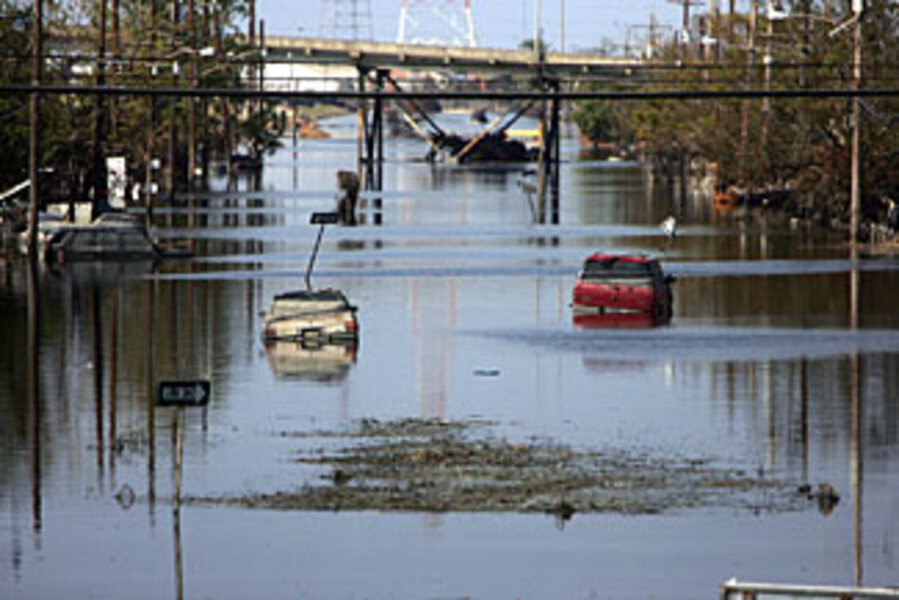Army Corps liable for Katrina damage, US court finds
| Atlanta
Confirming what many New Orleanians already knew in their hearts, a federal judge ruled late Wednesday that the Army Corps of Engineers – and thus the US government – is liable for a big chunk of the damage caused when hurricane Katrina pushed ashore on Aug. 29, 2005.
The landmark ruling awards $719,000 to four plaintiffs from the city's Lower Ninth Ward and neighboring St. Bernard Parish who filed suit in 2006. The only such liability suit to actually reach a courtroom, the so-called "Mr. Go" ruling (after a shipping channel in the area) opens the floodgates for a raft of new litigation from as many as 100,000 other residents.
More important, the ruling – which called the Army Corps "myopic" in its maintenance of the Mississippi River Gulf Outlet canal (aka Mr. Go) – now puts pressure on President Obama to help the region settle claims that could reach into the billions of dollars. (Without a court judgment, the Bush administration had refused calls for a settlement.)
At the beginning of the trial this summer, US District Court Judge Stanwood Duval asked, "You all know what this is about: ... What did the Corps know, when did it know it, and when should it have known?"
He answered in a 158-page ruling late Wednesday.
"It is the court's opinion that the negligence of the corps, in this instance by failing to maintain the MR-GO properly, was not policy, but insouciance, myopia, and shortsightedness," he wrote.
During testimony this summer, veteran Louisiana geologist Sherwood Gagliano, a former Corps consultant, testified that the Corps' failure to stop the natural widening of the canal caused it to eventually bump up against the shore of Lake Borgne, on the city's east side.
During the hurricane, that breach allowed waves on Lake Borgne to enter the Mr. Go and travel into the east side of the city, battering the levees to a degree to which they were not designed.
The 76-mile-long Mr. Go was built in 1965 as a shortcut from New Orleans to the Gulf of Mexico. It was closed to ship traffic this year.
"One of the greatest catastrophes in the history of the US" was both predictable and preventable, Mr. Gagliano testified.
Judge Duval had refused lawsuits placing blame on the city's Corps-designed levees, saying that in the case of storm protection systems the government has sovereign immunity. But because the Mr. Go is a navigation canal, not a storm-protection system, Duval allowed this case to proceed.
The government, for its part, took the "act of God" defense, arguing that the magnitude of the storm alone caused the flooding of New Orleans, the deaths of more than 700 residents, and $90 billion of damage across the region. Its ultimate point: Katrina was such a massive event that no remedial action on the Corps' part would have prevented the flooding.
The Corps of Engineers made no comment about Duval's ruling Wednesday but is expected to appeal. "The government's primary defense is that what we did, it did not cause this, and if it didn't cause it, there is no liability," Mark Davis, a professor at Tulane University Law School, told the Monitor this summer.
But for New Orleanians like Lorraine Washington, the trial and the outcome are about much more than money and finding closure to an event that has come to define the Big Easy. It's about, she said this summer, being made whole again.
Much of the Lower Ninth Ward, which took the brunt of the levee breaches caused by the Mr. Go, remains to this day scrubby open space, because many residents have been unable or unwilling to rebuild.
"Don't call this a natural disaster. It's a man-made disaster, and everyone in New Orleans knows that," New Orleans screenwriter John Biguenet said recently.
----
Floating house could ride New Orleans’ floods
Five things New Orleans wants from Obama
What Katrina has wrought four years later
----
Follow us on Twitter.





